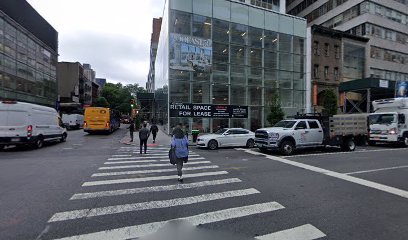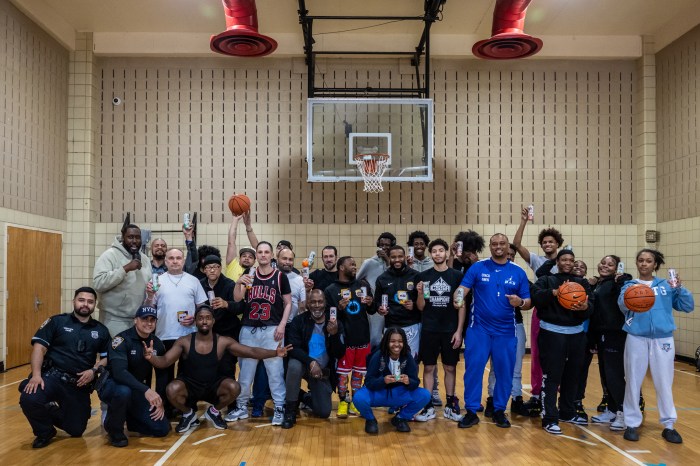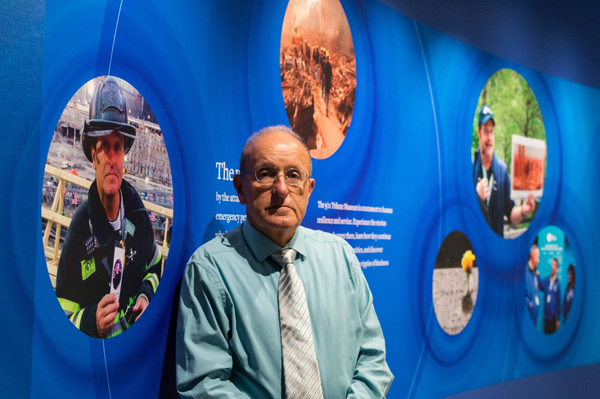
Tribute Museum co-founder Lee Ielpi stands next to a portrait of himself holding a photo of his firefighter son — whose death on 9/11 inspired him to help create the original tribute center with a mission to promote global understanding — as part of an exhibit on the “ripples” that spread out from those affected by the 9/11 attacks.
BY JACKSON CHEN
The 9/11 Tribute Museum reopens its doors this week at a new, expanded space befitting its broadened, enduring mission.
Founded more than a decade ago to provide a place where the survivors and families of victims of the 9/11 terrorist attacks could share their grief, and where the droves of out-of-towners making pilgrimages to Ground Zero could hear their stories, the center opened in a small space at 120 Liberty Street in 2006.
Even after the official National September 11 Memorial and Museum opened in 2014, interest in the personal stories celebrated at the Tribute Museum didn’t diminish, but in fact grew, and last year the founders announced plans to move to a much larger space at 92 Greenwich St.
Visitors to the new museum are greeted with a quote from the Dalai Lama: “Just as ripples spread out when a single pebble is dropped into the water, the actions of individuals can have far-reaching effects.”
But the quote does not refer to the sprawling War of Terror unleashed by the 19 hijackers, explains Lee Ielpi, the co-founder and board president of the museum, but rather the ongoing outpouring of charity, volunteerism, and patriotism America experienced when they saw thousands of first responders as well as ordinary citizens rush to Ground Zero form all over the country to help, and then often returned home with a new sense of civic mindedness.
“As you go through, you’re going to start seeing the ripples, and how they’re going to spread out and make a positive out of a negative,” Ielpi said.
With triple the space of its former location, the Greenwich Street location allows the museum to present a much broader vision of the World Trade center attack and its aftermath, for the neighborhood, the nation, and the world
The museum begins with a short walkthrough of the World Trade Center’s history and leads directly into halls that offer harrowing videos and news reports of the towers’ collapse, and personal accounts of those who witnessed it or escaped.
“Every time I see this one spot, I say ‘Oh my gosh, look at that, it’s like an animal,’ ” Ielpi said of the video that showed how the vast, opaque, otherworldly cloud of dust billowed out and consumed the city streets as the towers came down.
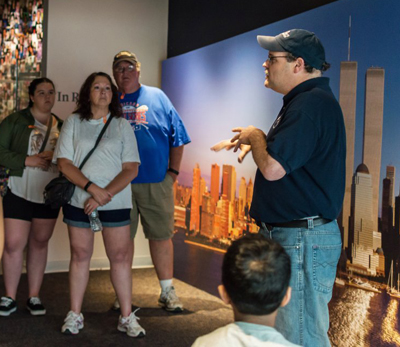
Downtown resident Ray Birge shares with visitors his story of how he survived 9/11, and how he decided to remain in his neighborhood throughout the aftermath.
The museum also features an open room where visitors can stop and listen to live talks from volunteers who were impacted by 9/11. Ray Birge, a survivor who lived at 50 Battery Place at the time, for example, shares how he was able to escape the chaos that tore though his neighborhood that morning — but also how he decided not to escape the toxin-covered remnants of his neighborhood, itself, but rather stay and help rebuild. Birge and many others affected by the incident serve as volunteer docents for the museum.
“This is a way of remembering and paying tribute,” Birge said of the new museum. “This is a place of healing and remembering, and I think it’s a treasure for Lower Manhattan.”
Most importantly, the museum offers a pathway from grief to hope.
One of its most poignant spaces is a somberly lit memorial room filled with family-provided photos of the thousands of innocent people who died in the towers’ collapse — smiling family photos, graduation portraits, vacation snapshots all hinting at a happier times tragically cut short by an act of unspeakable evil.
But that dark tunnel of sorrow then opens to an airy, well-lit hall filled with exhibits highlighting the myriad good works throughout the country and the world that are now being carried out by people affected, directly of indirectly, by that same act.
According to museum co-founder and CEO Jennifer Adams-Webb, the positivity that has come out of 9/11 is an important part of the museum’s story.
“[We’re] able to say you can be that droplet that ripples out to touch other people around the world by being inspired to do something in your community,” Adams-Webb said.
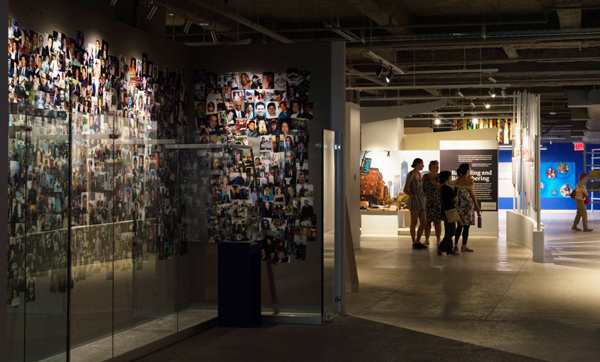
A dimly lit room features photos of thousands of 9/11 victims that were submitted by their families, but leads into a brighter portion of the museum that celebrates the tens of thousands of survivors, first responders, and volunteers who rallied to clean up and remake Lower Manhattan in the weeks and months that followed.











